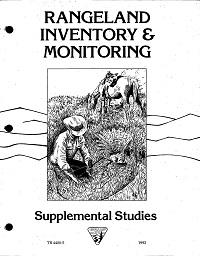Rangeland Inventory and Monitoring: Supplemental Studies

This Technical Reference contains the rangeland inventory and monitoring techniques historically used in the Bureau since the formation of the Grazing Service; It does not include local or regional techniques. Where manuals could not be located, the best available documentation was used.
Every effort has been made to accurately transcribe the original manuals. Editing was limited to the introductory Editor's Notes in Sections I - XII and XVII - XTX to preserve the original wording intact. However, Sections XIII - XVI were rewritten for clarity, since there was no need to be concerned about preserving an original manuscript.
This technical reference is designed to be a reference document. It is not intended as an endorsement of these methods as Bureau-approved procedures. Many existing case files (allotment and operator files) and district files contain resource information gathered using procedures that are no longer approved methods. Some of this data is still being used to determine the grazing preference on public land and the carrying capacity on nonfederal lands. The procedures employed by some of these methods are now obscure. Since this resource information is still being used, this document will help to explain how the data was collected. It also provides instructions on how to collect data for future comparison.
Historical inventory and monitoring data are often useful for making long-term analyses of trends and ecological change. Although some historical techniques may be considered to be technically inadequate, the data may still be useful in making general interpretations. Knowledge of the intent or purpose of historical methods aids in understanding why previous range managers managed the range the way they did, and in determining if certain reports, e.g., range condition, can be compared to the concepts and reports used today.
It is very important for future reference that any old monitoring and inventory data not be disposed of.
